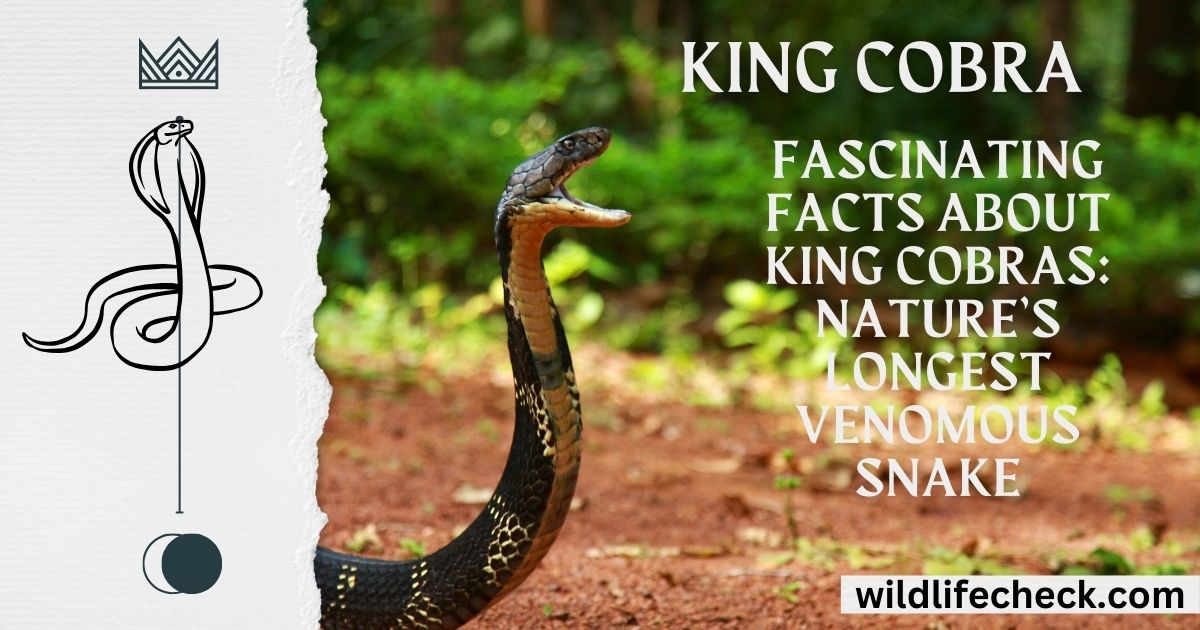
Fascinating Facts About King Cobras: Nature’s Longest Venomous Snake
Fascinating Facts About King Cobras: The king cobra, eminent as the world’s longest venomous snake, captivates both researchers and devotees alike with its noteworthy measure and striking appearance.
Found fundamentally in Southeast Asia, this momentous serpent shows one of a kind behaviors, such as its capacity to raise a critical parcel of its body off the ground and its complex mating customs.
With powerful poison and a count calories essentially comprising of other snakes, king cobras play a imperative part in their biological systems.�
Diving into their interesting characteristics uncovers a intriguing world where excellence meets peril, making the king cobra a genuinely exceptional animal.
- Overview of the Species
- Myth and Reality: Debunking Common Misconceptions About King Cobras
- Size Matters: Understanding the Impressive Length of King Cobras
- Venomous Wonders: The Potent Bite of the King Cobra
- Habitat and Range: Where to Find King Cobras in the Wild
- Diet and Hunting Strategies: How King Cobras Capture Their Prey
- Unique Mating Rituals: The Courtship of King Cobras
- Cultural Significance: King Cobras in Folklore and Mythology
- Conservation Status: Protecting the King Cobra’s Natural Habitat
- Incredible Adaptations: How King Cobras Thrive in Their Environment
- The Art of Camouflage: King Cobras and Their Surprising Disguises
- Behavioral Insights: What Makes King Cobras Unique Among Snakes
- Famous Encounters: Legendary Stories of Human-King Cobra Interactions
- The King Cobra in Captivity: Challenges and Care in Zoos
- Future of the King Cobra: Conservation Efforts and What Lies Ahead
- what are interesting facts about king cobras
- FAQ’s About what are interesting facts about king cobras
- Conclusion�
Key Takeaways
- Noteworthy Size: Lord cobras can grow up to 18 feet in length, making them the longest venomous snake on the planet.
- Powerful Toxin: Their toxin is exceptionally harmful and can kill a grown-up elephant in only a couple of hours, however they seldom represent a danger to people except if incited.
- Remarkable Way of behaving: Lord cobras can take dependent upon 33% of their body off the ground and are known for their hood show when undermined.
- Diet: They principally feed on different snakes, including venomous species, and have a specific hunting strategy.
- Mating Ceremonies: Lord cobras display intriguing romance ways of behaving, including wrestling between guys to lay out strength.
- Territory: They flourish in different conditions, including timberlands, prairies, and close to water sources across Southeast Asia.
- Social Importance: In different societies, ruler cobras are viewed as images of force and are many times highlighted in legends and folklore.
- Protection Status: Albeit not right now jeopardized, living space misfortune and hunting present critical dangers to their populaces.
- Knowledge: Ruler cobras show surprising critical thinking abilities and are viewed as one of the more wise snake species.
- Remarkable Life expectancy: In bondage, ruler cobras can satisfy 20 years, exhibiting their versatility to various conditions.
Overview of the Species
The king cobra (Ophiophagus hannah) is the world’s longest venomous snake, fit for growing up to 18 feet. Found basically in Southeast Asia, it possesses timberlands, prairies, and marshes.
Known for its particular hood and strong toxin, it essentially goes after different snakes. Albeit by and large isolated, the lord cobra assumes a fundamental part as a top hunter in its biological system.
At present, it is named “Least Concern,” however faces dangers from natural surroundings misfortune and hunting.
Physical Characteristics
The king cobra (Ophiophagus hannah) has a few particular actual qualities:
- Size: It is the longest venomous snake on the planet, normally going from 10 to 13 feet, for certain people arriving at up to 18 feet.
- Tinge: Lord cobras have a variable variety design, as a rule including shades of olive, brown, or dark, frequently with lighter markings or stripes along their bodies.
- Hood: They are well known for their noticeable hood, which they can grow when undermined. This hood is upheld by prolonged ribs and fills in as an advance notice show.
- Head Shape: Their heads are enormous and marginally more extensive than their necks, with particular, adjusted noses.
- Eyes: Ruler cobras have huge, round eyes with vertical cut students, improving their vision in low light.
- Scales: Their scales are smooth and gleaming, supporting development through different landscapes.
Myth and Reality: Debunking Common Misconceptions About King Cobras
Common Myths Explained
- Fantasy: Lord Cobras Are Forceful and Assault People Every now and again
- Reality: Lord cobras are by and large timid and really like to keep away from human contact. They will possibly strike when undermined or cornered, making them less forceful than normally accepted.
- Legend: Ruler Cobras Can Gulp down People
- Truth: While lord cobras can consume enormous prey, for example, different snakes, their jaws are not intended to swallow something as extensive as a human. This fantasy is to a great extent sensationalized.
- Fantasy: All Venomous Snakes Are Deadly to People
- Truth: In spite of the fact that ruler cobra toxin is strong, fatalities from chomps are generally uncommon because of successful clinical treatment and neutralizer accessibility. Most chomps happen when snakes are incited.
- Fantasy: Ruler Cobras Have some control over Their Toxin
- Truth: Ruler cobras don’t deliberately control their toxin yield. They normally infuse toxin when they nibble, yet they might convey a “dry chomp” (without toxin) in the event that they feel compromised.
- Fantasy: Lord Cobras Are the Most Toxic Snakes
- Reality: While ruler cobra toxin is exceptionally harmful, the expression “generally noxious” can deceive. Harmfulness differs by species and setting; a few snakes have toxin that is more powerful on a milligram-per-milligram premise.
- Fantasy: Ruler Cobras Are Safe to Their Own Toxin
- Truth: In the same way as other snakes, ruler cobras are not safe to their toxin. If they somehow managed to infuse themselves, it very well may be deadly.
The Truth Behind Their Reputation
King cobras have procured a fearsome standing because of their size, powerful toxin, and striking appearance.
Nonetheless, a lot of their reputation is overstated. While they are equipped for conveying a hazardous chomp, they are by and large hermitic and really like to keep away from a showdown.
Their cautious way of behaving, like raising their hoods and murmuring, is frequently misconstrued as hostility. Truly, lord cobras assume a fundamental biological part as top hunters, assisting control with winding populaces.
Understanding their actual way of behaving and natural significance can assist with moderating trepidation and advance protection endeavors.
Size Matters: Understanding the Impressive Length of King Cobras
Record-Breaking Lengths
King cobras are prestigious for their amazing lengths, with the typical grown-up estimating between 10 to 13 feet (3 to 4 meters).
Be that as it may, a few excellent people have been recorded at lengths surpassing 18 feet (5.5 meters), making them the longest venomous snakes on the planet.
One of the longest affirmed examples was estimated at around 19.2 feet (5.8 meters). Their momentous size separates them inside the snake family as well as adds to their status as dominant hunters in their living spaces.
Comparing Sizes with Other Snakes
While looking at sizes, the lord cobra stands apart as the longest venomous snake, ordinarily going from 10 to 13 feet (3 to 4 meters) and sometimes surpassing 18 feet (5.5 meters). Conversely, other remarkable snakes include:
- Green Boa constrictor: One of the biggest snakes by weight and size, frequently comparing 20 feet (6 meters), yet not venomous.
- Reticulated Python: Can likewise develop north of 20 feet (6 meters) and is the longest snake generally speaking, however it is non-venomous.
- Gaboon Snake: Perhaps of the biggest venomous snake, arriving at lengths of around 6 feet (1.8 meters).
While the ruler cobra isn’t the heaviest or the longest by and large, its remarkable mix of length and venomous capacity makes it an imposing presence in the snake world.
Venomous Wonders: The Potent Bite of the King Cobra
Venom Composition and Effects
Ruler cobra toxin is a mind boggling combination of neurotoxins, cytotoxins, and catalysts. Key parts include:
- Neurotoxins: These influence the sensory system, upsetting correspondence among nerves and muscles, which can prompt loss of motion. This is the essential component that makes lord cobra chomps possibly lethal.
- Cytotoxins: These poisons harm cells and tissues, prompting enlarging, putrefaction, and inside draining at the nibble site.
- Phospholipases: These compounds separate cell layers, adding to the generally disastrous impacts of the toxin.
The impacts of a ruler cobra chomp can incorporate serious torment, enlarging, wooziness, respiratory disappointment, and, if untreated, can be lethal in practically no time. Brief clinical treatment and counter-agent are basic for endurance following a nibble.
Treatment for King Cobra Bites
Treatment for ruler cobra chomps is basic and ought to be managed as fast as could be expected. Key advances include:
Look for Guaranteed Clinical Consideration: Call crisis benefits or get the casualty to a clinic rapidly, as brief treatment is fundamental.
Keep the Casualty Quiet: Lessening development can assist with easing back the spread of toxin through the circulatory system.
Immobilize the Impacted Appendage: Keep the nibbled appendage at or somewhat underneath heart level to limit toxin spread.
Keep away from Specific Medical aid Measures:
- Try not to Apply a Tourniquet: This can confine blood stream and deteriorate tissue harm.
- Try not to Cut the Injury: Slicing can prompt contamination and extra mischief.
- Try not to Endeavor to Suck Out the Toxin: This is inadequate and can present microbes.
Regulate Neutralizer: At a clinical office, counter-agent well defined for lord cobra toxin will be controlled to balance the impacts of the toxin.
Steady Consideration: Extra medicines might incorporate agony the executives, wound care, and observing for complexities like respiratory trouble.
Ideal and fitting clinical mediation essentially expands the possibilities of recuperation from a lord cobra nibble.
Habitat and Range: Where to Find King Cobras in the Wild
Preferred Environments
King cobras incline toward assorted environments, including trop
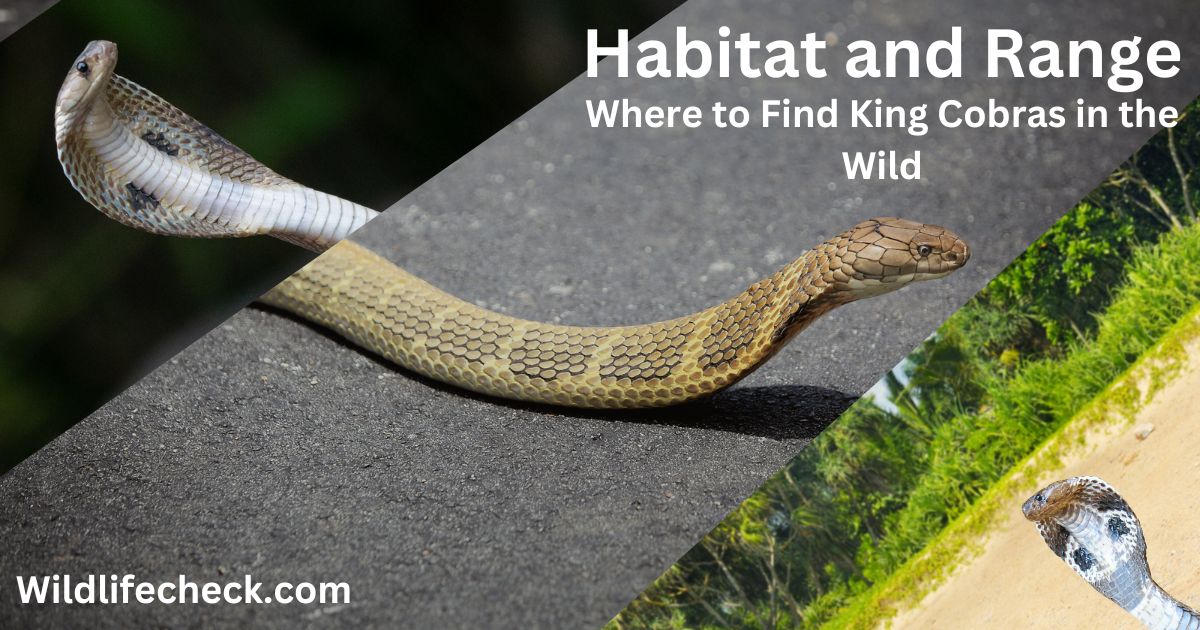
ical and subtropical timberlands, prairies, and regions close to water sources like streams and marshes.
They are much of the time found in thick vegetation, which gives cover to hunting and assurance. Their flexibility permits them to flourish in both provincial and forested conditions across Southeast Asia.
Geographic Distribution
King cobras are basically tracked down in Southeast Asia, with their geographic dispersion spreading over a few nations. They possess areas in India, Myanmar, Thailand, Laos, Cambodia, Vietnam, Malaysia, Indonesia, and the Philippines.
They favor muggy, tropical conditions yet can likewise be tracked down in neighboring fields and marshes. Their reach mirrors their flexibility to different environments, however they are generally usually connected with thick forested regions.
Diet and Hunting Strategies: How King Cobras Capture Their Prey
Typical Diet
The run of the mill diet of king cobras fundamentally comprises of different snakes, including both venomous and non-venomous species. They are known to go after cobras, rodent snakes, and, surprisingly, other lord cobras.
Notwithstanding snakes, they may periodically consume reptiles and little warm blooded creatures. Ruler cobras are gifted trackers, utilizing their brilliant feeling of smell to find prey and their strong toxin to immobilize it before utilization.
Hunting Techniques
Ruler cobras utilize a few compelling hunting strategies:
- Trap Hunting: They frequently lie on pause among vegetation, utilizing their cover to mix into the environmental elements and shock clueless prey.
- Dynamic Scavenging: Ruler cobras may effectively look for prey, utilizing their sharp feeling of smell to recognize fragrances and find different snakes.
- Striking and Envenomating: When they find their prey, they hit with speed, conveying an intense nibble that infuses toxin to immobilize it.
- Gulping down: Subsequent to repressing their prey, lord cobras can consume it entire, on account of their adaptable jaws and the capacity to unhinge their mouths.
These methods feature their flexibility and expertise as dominant hunters in their environments.
Unique Mating Rituals: The Courtship of King Cobras
Mating Behavior
Lord cobra mating conduct is entrancing and includes a few interesting ceremonies:
- Romance Presentations: During the rearing season, guys take part in romance shows that incorporate mind boggling developments and murmuring to draw in females.
- Battle Wrestling: Male lord cobras frequently participate in wrestling matches to lay out predominance and gain mating freedoms. They entwine their bodies and attempt to overwhelm one another.
- Mating Cycle: After effective romance, the male falls in line with the female, and relations happens, enduring a few hours.
- Egg Laying: Females lay grasps of 20 to 50 eggs in a safeguarded home, frequently in leaf litter or other vegetation. Astoundingly, the female will loop around the eggs to safeguard them until they hatch, showing maternal consideration.
These ways of behaving feature the intricacy and seriousness of lord cobra proliferation.
Nesting and Egg-Laying
Settling and egg-laying in ruler cobras include a few key perspectives:
- Settling Locales: Female lord cobras normally select secret areas, for example, thick vegetation or leaf litter, to make a home. These destinations give assurance from hunters and ecological components.
- Egg Grips: A female can lay between 20 to 50 eggs in a solitary grasp. The eggs are delicate shelled and have a rough surface.
- Maternal Consideration: Dissimilar to many snake species, the female lord cobra displays maternal way of behaving. She curls around her eggs to shield them from hunters and keep up with stickiness. This conduct goes on until the eggs hatch, normally inside 60 to 80 days.
- Bring forth: When the eggs hatch, the youthful snakes are autonomous and get no further consideration from the mother, beginning their lives as singular animals.
This regenerative technique mirrors the flexibility and care that ruler cobras put resources into guaranteeing the endurance of their posterity.
Cultural Significance: King Cobras in Folklore and Mythology
Symbolism in Different Cultures
Lord cobras hold critical imagery in different societies, frequently epitomizing subjects of force, risk, and shrewdness:
- Hinduism: In India, the ruler cobra is related with Master Shiva, who is frequently portrayed with snakes around his neck. This represents assurance, interminability, and the repeating idea of life.
- Buddhism: The lord cobra is at times seen as a defender and an image of illumination, mirroring defeating dread and enticement.
- Legends: In numerous Southeast Asian societies, ruler cobras are viewed as watchmen of the timberland, addressing strength and secret. They frequently show up in nearby legends and fantasies, featuring their adored status.
- Craftsmanship and Tattoos: The ruler cobra is a well known theme in tattoos and workmanship, representing resurrection, change, and flexibility because of its capacity to shed its skin.
- Odd notions: A few societies accept that experiencing a ruler cobra can bring positive or negative karma, mirroring the double idea of this strong animal.
By and large, the lord cobra’s imagery mirrors its grand presence and the regard it orders in different social accounts.
King Cobras in Art and Literature
Ruler cobras have enlivened a large number of creative articulations and scholarly works, mirroring their strong presence and imagery:
- Workmanship: In customary and contemporary craftsmanship, ruler cobras are frequently portrayed to represent strength, security, and secret. Their striking appearance makes them a famous subject in canvases, models, and material plans across societies.
- Writing: Ruler cobras highlight unmistakably in legends, fables, and present day writing. They are frequently depicted as gatekeepers or adversaries, exemplifying subjects of risk and insight. In certain accounts, they represent change or the battle among great and wickedness.
- Verse: Writers have utilized the symbolism of ruler cobras to convey profound feelings and experiences, frequently investigating subjects of dread, regard, and the regular world.
- Film and Media: Ruler cobras show up in different movies and narratives, frequently portrayed as considerable animals that bring out wonder and dread, displaying their part in environments.
Through these different mediums, lord cobras keep on spellbinding crowds, filling in as strong images in both workmanship and writing.
Conservation Status: Protecting the King Cobra’s Natural Habitat
Current Threats to Their Survival
Ruler cobras face a few critical dangers to their endurance:
- Living space Misfortune: Deforestation and urbanization lead to the annihilation of their normal territories, diminishing accessible sanctuary and food sources.
- Poaching and Hunting: Ruler cobras are frequently pursued for their skin, meat, and use in customary medication, prompting populace declines.
- Human Infringement: As human populaces venture into their regions, experiences with ruler cobras increment, frequently bringing about retaliatory killings.
- Environmental Change: Changes in environment can disturb their territories and prey accessibility, influencing their endurance.
- Contamination: Pesticides and different toxins can sully their surroundings, affecting their wellbeing and conceptive achievement.
Preservation endeavors are fundamental to relieve these dangers and safeguard ruler cobra populaces in nature.
Conservation Efforts and Initiatives
Preservation endeavors for ruler cobras center around safeguarding their environments and lessening human-snake clashes. Key drives include:
- Living space Security: Laying out and keeping up with safeguarded regions and untamed life stores to save normal environments where ruler cobras flourish.
- Government funded Instruction: Bringing issues to light about the environmental significance of lord cobras and elevating conjunction systems to diminish dread and misjudging among neighborhood networks.
- Examination and Checking: Directing logical exploration to all the more likely figure out ruler cobra conduct, populace elements, and nature, which illuminates preservation systems.
- Hostile to Poaching Measures: Carrying out regulations and guidelines to shield ruler cobras from unlawful hunting and exchange, alongside watching regions known for poaching action.
- Salvage and Recovery: Setting up natural life salvage focuses to really focus on harmed or dislodged ruler cobras, giving restoration prior to delivering them back into nature.
- Local area Contribution: Drawing in nearby networks in preservation endeavors, empowering supportable practices that benefit both untamed life and individuals.
These drives are urgent for guaranteeing the drawn out endurance of ruler cobras and keeping up with sound environments.
Incredible Adaptations: How King Cobras Thrive in Their Environment
Physical Adaptations
Ruler cobras display a few actual transformations that improve their endurance and hunting effectiveness:
- Long, Thin Body: Their lengthened body takes into consideration productive development through thick vegetation and empowers them to strike rapidly at prey.
- Hood: The unmistakable hood can be extended while undermined, filling in as an advance notice show to hinder possible hunters and contenders.
- Smooth Scales: Their smooth, gleaming scales decrease grinding, considering quick development through different landscapes, including water.
- Strong Muscular build: Solid muscles give the capacity to contract and stifle prey successfully, as well as to climb trees if essential.
- Sharp Detects: Ruler cobras have great vision and an exceptionally evolved feeling of smell, supported by their forked tongues, which assist them with finding prey and explore their current circumstance.
- Venomous Teeth: Their long, empty teeth can convey intense toxin, permitting them to immobilize prey rapidly and actually.
These transformations make lord cobras profoundly effective hunters and empower them to flourish in their different living spaces.
Behavioral Adaptations
Ruler cobras show a few conduct variations that improve their endurance and hunting achievement:
- Single Nature: Lord cobras are for the most part lone, lessening contest for assets and permitting them to chase all the more successfully without obstruction from others.
- Trap Hunting: They frequently utilize snare strategies, staying still in vegetation until prey comes close, considering an unexpected assault.
- Guarded Show: When compromised, they raise their hoods and murmur, showing hostility to dissuade hunters without turning to a nibble.
- Occasional Mating: Ruler cobras take part in unambiguous mating ways of behaving during the reproducing season, including romance ceremonies and battle wrestling between guys to lay out strength.
- Thermoregulation: They can be dynamic during the day or night, contingent upon temperature and ecological circumstances, permitting them to really manage internal heat level.
- Home Security: Females display maternal consideration by looping around their eggs, shielding them from hunters and keeping up with moistness until they hatch.
These social variations mirror their capacity to flourish in different conditions and guarantee the continuation of their species.
The Art of Camouflage: King Cobras and Their Surprising Disguises
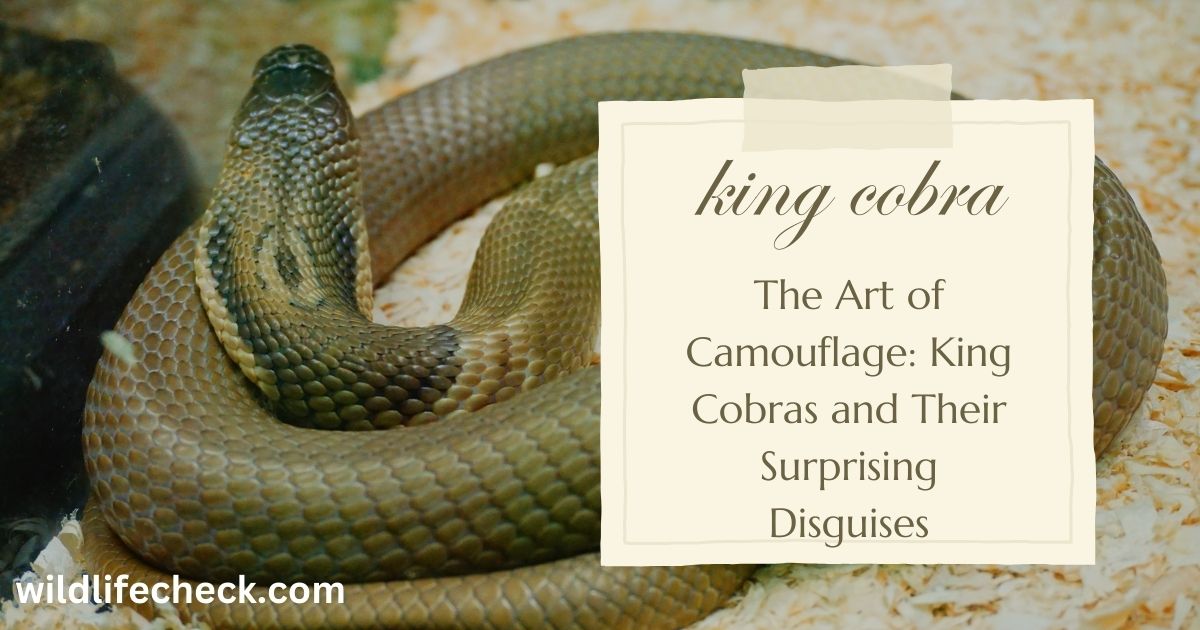
How Camouflage Works
The king cobra utilizes cover essentially through its shading and examples, which assist it with mixing into the leaf litter and underbrush of its regular natural surroundings.
Its scales can mirror the shades of the timberland floor, making it harder for prey and hunters to detect it. This secretive appearance permits the lord cobra to snare prey really while remaining stowed away from possible dangers.
Examples of Effective Camouflage
The king cobra shows compelling disguise through:
- Shading: Its scales can go from olive green to yellow and dark, permitting it to mix into the verdant backwoods floor and underbrush.
- Design Interruption: The snake’s examples can separate its layout, making it harder to detect against the differed surfaces of its current circumstance.
- Conduct Cover: While resting, the ruler cobra frequently loops up stays actually, further improving its capacity to stay inconspicuous.
These transformations assist it with staying disguised from the two hunters and prey right at home.
Behavioral Insights: What Makes King Cobras Unique Among Snakes
Social Behavior
- Single Nature: Lord cobras are principally singular animals, liking to live alone besides during mating season.
- Regional Way of behaving: Guys might display territoriality, taking part in battle with different guys to lay out predominance and secure reproducing freedoms.
- Mating Customs: During mating, guys play out a “dance” where they lace and raise their bodies, displaying strength and wellness.
- Maternal Consideration: Females display uncommon maternal conduct by safeguarding their eggs and remaining close to the hatchlings after they arise, a unique case among snakes.
- Correspondence: Lord cobras use non-verbal communication, for example, hooding and pose, to impart dangers and affirm strength.
- Stress Reactions: When undermined, they might murmur or show their hoods to caution off possible dangers without turning to animosity.
These ways of behaving add to their endurance and conceptive outcome in their normal territories.
Defensive Strategies
- Hood Show: When undermined, the lord cobra can extend its neck to shape a hood, causing it to seem bigger and more scary to possible hunters.
- Murmuring and Vocalization: They frequently murmur boisterously as an advance notice sign to discourage dangers, flagging that they are prepared to shield themselves.
- Disguise: Their hue and examples assist them with mixing into their environmental factors, permitting them to stay away from recognition.
- Striking: Whenever incited, lord cobras can convey a speedy and strong chomp, infusing intense toxin as a protection component.
- Retreat Conduct: Instead of connecting with, ruler cobras might decide to withdraw to keep away from a conflict, showing an inclination for evasion over hostility.
- Remaining Still: When they feel undermined yet not straightforwardly gone after, they might stay unmoving, depending on their disguise to slip through the cracks.
These systems assist lord cobras make due in the wild by limiting experiences with hunters.
Famous Encounters: Legendary Stories of Human-King Cobra Interactions
Notable Incidents
- Venomous Nibbles: There have been various reports of serious chomps in locales where lord cobras are normal, frequently including snake controllers or individuals residing close to their natural surroundings.
- Experiences in Metropolitan Regions: Ruler cobras have once in a while meandered into metropolitan settings, prompting sensational salvages by natural life authorities, displaying the pressure between metropolitan turn of events and natural life.
- Research Studies: Different examinations on ruler cobras have featured their way of behaving and toxin properties, prompting bits of knowledge into snake physiology and likely clinical applications.
- Far-reaching developments: In certain societies, ruler cobras are highlighted in conventional celebrations and customs, mirroring their importance in neighborhood folklore and convictions.
- Preservation Endeavors: Expanded mindfulness about lord cobras has prompted preservation programs pointed toward safeguarding their territories and diminishing human-snake clashes.
These episodes feature the perplexing connection between ruler cobras and people, as well as the significance of understanding and monitoring these striking reptiles.
Lessons Learned from Encounters
- Regard for Untamed life: Experiences highlight the significance of regarding the regular living spaces of ruler cobras and other untamed life, advancing conjunction.
- Security Mindfulness: Attention to wind conduct and environment can assist with forestalling risky experiences, underscoring the requirement for schooling in networks close to their living spaces.
- Crisis Readiness: Seeing medical aid for snake chomps and having crisis contacts can save lives in the event of an experience.
- Preservation Significance: Occurrences feature the requirement for preservation endeavors to safeguard ruler cobras and their biological systems, guaranteeing biodiversity.
- Social Awareness: Perceiving the social meaning of ruler cobras in neighborhood customs can cultivate regard and advance local area commitment in protection.
- Research Valuable open doors: Experiences frequently lead to investigate on snake conduct and toxin, upgrading logical information and clinical progressions.
These examples can assist with diminishing struggles and advance a more secure and more educated way to deal with living close by these interesting reptiles.
The King Cobra in Captivity: Challenges and Care in Zoos
Captive Breeding Programs
- Reason: Hostage rearing projects expect to ration ruler cobra populaces, particularly in regions where they are compromised by territory misfortune and poaching.
- Hereditary Variety: These projects assist with keeping up with hereditary variety via cautiously choosing reproducing matches, which is vital for the drawn out wellbeing of the populace.
- Schooling and Mindfulness: Hostage rearing offices frequently act as instructive focuses, bringing issues to light about the significance of ruler cobras and the dangers they face.
- Research Open doors: Hostage conditions permit specialists to concentrate on ruler cobra conduct, physiology, and multiplication, adding to protection science.
- Renewed introduction Endeavors: Effective reproducing projects can prompt renewed introduction drives, where hostage reared snakes are delivered into their regular natural surroundings to reinforce wild populaces.
- Associations: Many projects team up with neighborhood networks, protection associations, and states to guarantee compelling preservation methodologies and advance concurrence.
Hostage reproducing programs assume a crucial part in the preservation of ruler cobras, assisting with getting their future in nature.
Ethical Considerations in Keeping King Cobras
- Creature Government assistance: Guaranteeing the physical and mental prosperity of lord cobras is central, requiring extensive, enhanced conditions that impersonate their normal territories.
- Ability and Obligation: Just prepared experts ought to deal with lord cobras, given their venomous nature and complex consideration needs. This guarantees both human wellbeing and legitimate creature care.
- Preservation Effect: Continuing ruler cobras in bondage ought to add to protection endeavors, like rearing projects or instructive effort, as opposed to just for show or diversion.
- Legitimate Guidelines: Complying to nearby and global regulations in regards to the possession and exchange of venomous snakes is urgent to forestall unlawful untamed life dealing.
- State funded Instruction: Moral keeping includes teaching general society about the biological job of lord cobras and the significance of saving their normal living spaces.
- Risk The board: Legitimate wellbeing conventions should be set up to relieve dangers to both the guardians and general society, including secure fenced in areas and crisis reaction plans.
Tending to these moral contemplations advances capable stewardship and adds to the more extensive objectives of natural life protection.
Future of the King Cobra: Conservation Efforts and What Lies Ahead
The Role of Education in Conservation
Training is fundamental for king cobra preservation as it brings issues to light about their biological job, scatters legends, and advances conjunction techniques.
It enables networks to take part in preservation endeavors, upholds research drives, and features the social meaning of these snakes.
By cultivating understanding and regard, instruction guarantees the endurance of lord cobras and their natural surroundings.
Future Research and Exploration
Why Is the King Cobra Called “King”?
The Origin of the Name
The name “king cobra” comes from the snake’s amazing size and status as the longest venomous snake on the planet.
The expression “cobra” is gotten from the Portuguese word “cobra de capelo,” signifying “snake with a hood,” which alludes to its particular hood that it shows when compromised. The “lord” implies its strength in the snake family.
Significance in Ecosystem Hierarchy
King cobras assume a critical part in the environment pecking order as top hunters, assisting with controlling populaces of different snakes and little vertebrates.
Their presence demonstrates a solid environment, and they add to biodiversity by keeping up with balance in their natural surroundings. By controlling prey populaces, they assist with forestalling overpopulation and the resulting exhaustion of assets.
Top 10 Facts about King Cobras�
- Length: Lord cobras are the longest venomous snakes, arriving at lengths of up to 18 feet (5.5 meters).
- Toxin: Their toxin is profoundly powerful and can convey an adequate number of neurotoxins to kill a grown-up elephant in one nibble.
- Diet: Not at all like many snakes, lord cobras essentially eat different snakes, including venomous species.
- Hood Show: They can extend their necks to shape a hood while compromised, causing them to seem bigger and seriously scary.
- Insight: Lord cobras display critical abilities to think and complex ways of behaving, exhibiting their knowledge among reptiles.
- Natural surroundings: They are ordinarily tracked down in timberlands, prairies, and close to water sources across Southeast Asia and portions of India.
- Mating Customs: During mating season, guys take part in intricate shows and wrestling matches to seek females.
- Egg-laying: Female ruler cobras are one of a kind in that they fabricate homes for their eggs and may remain with them until they hatch.
- Life expectancy: In the wild, ruler cobras can satisfy 20 years, however they might live longer in bondage.
- Social Importance: Lord cobras are respected in different societies and are frequently connected with fantasies and legends, representing power and risk.
what are interesting facts about king cobras
| Fact | Description |
|---|---|
| Length | King cobras can grow up to 18 feet (5.5 meters), making them the longest venomous snake. |
| Venom | Their venom is neurotoxic and can kill an adult elephant with a single bite. |
| Diet | They primarily eat other snakes, including venomous ones, showcasing their predatory nature. |
| Hood Display | When threatened, they expand their necks to form a hood, making themselves look larger. |
| Intelligence | King cobras are known for their problem-solving abilities and complex behaviors. |
| Habitat | They inhabit forests, grasslands, and areas near water across Southeast Asia and India. |
| Mating Rituals | Males engage in wrestling matches to compete for females during mating season. |
| Egg-laying | Females build nests for their eggs and may guard them until they hatch. |
| Lifespan | In the wild, they can live up to 20 years, with longer lifespans reported in captivity. |
| Cultural Significance | King cobras are featured in various myths and folklore, symbolizing power and danger. |
FAQ’s About what are interesting facts about king cobras
How long can king cobras grow?
King cobras can arrive at lengths of up to 18 feet (5.5 meters), making them the longest venomous snake.
What do king cobras eat?
They fundamentally feed on different snakes, including venomous species, exhibiting their job as top hunters.
How do king cobras defend themselves?
When compromised, they grow their necks to frame a hood, which causes them to seem bigger and seriously scary.
Do king cobras care for their young?
Indeed, female king cobras assemble homes for their eggs and may remain with them until they hatch.
What is the significance of king cobras in culture?
King cobras are in many cases highlighted in legends and fables, representing power, risk, and regard in different societies.
Conclusion�
In conclusion, king cobras are not just the longest venomous snakes on the planet yet additionally captivating animals with extraordinary ways of behaving and biological importance.
Their amazing size, powerful toxin, and job as top hunters feature their significance in keeping up with the equilibrium of their environments. Moreover, their social importance and interesting settling propensities mirror the profound associations people have with these great reptiles.
Understanding and valuing these realities can motivate more noteworthy endeavors in their preservation and security.

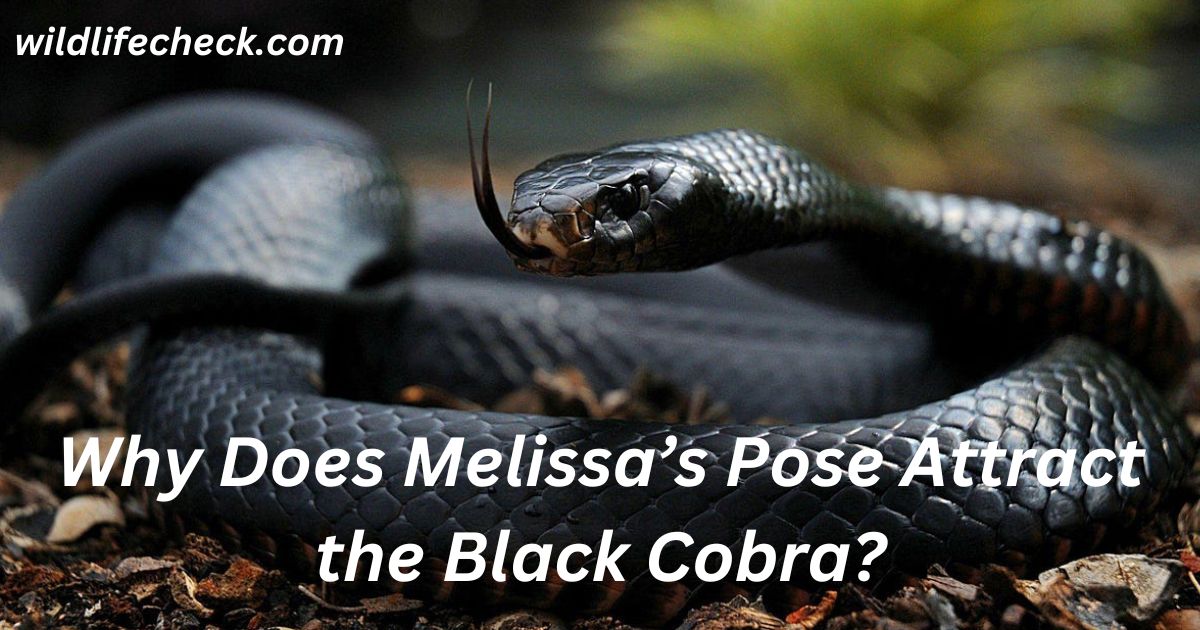
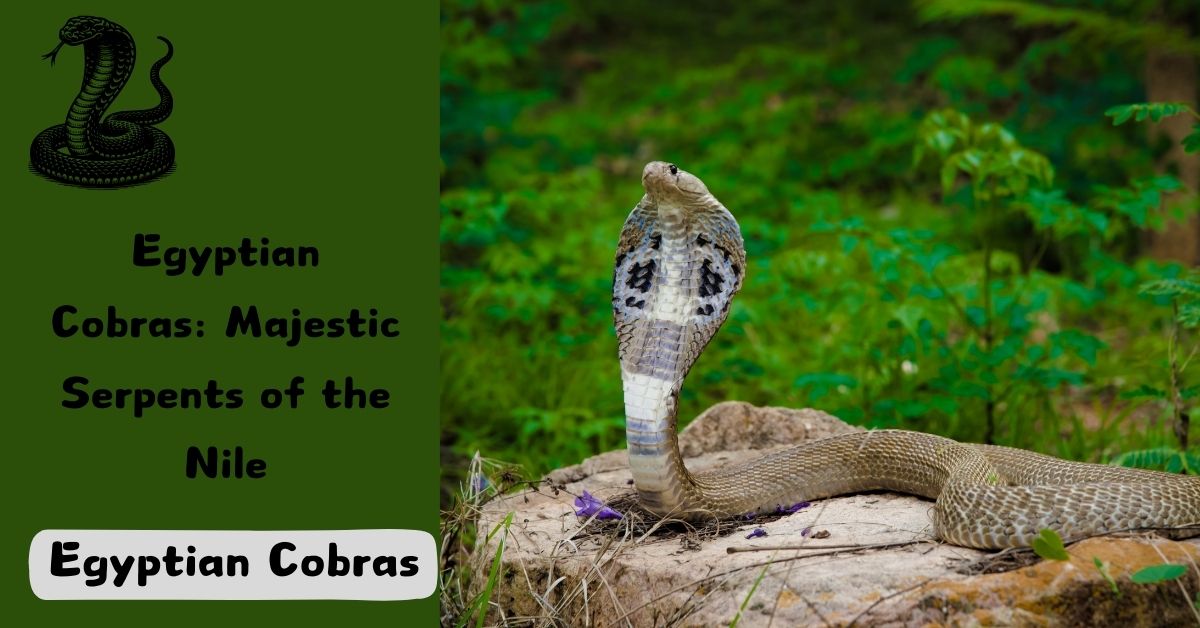
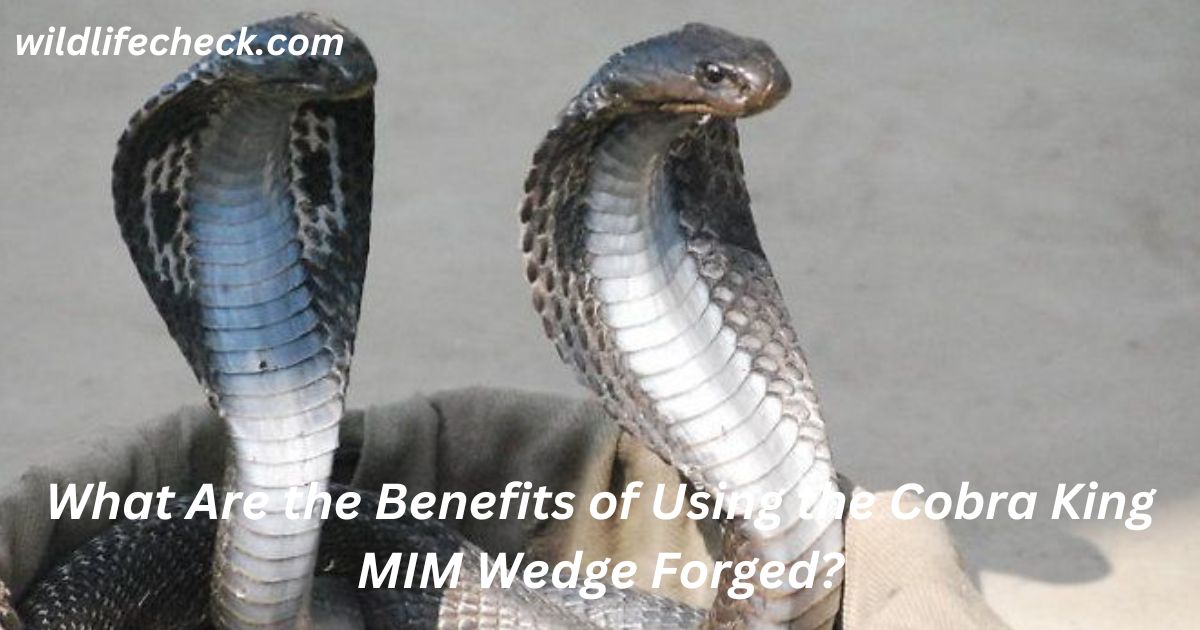

Excellent read, I just passed this onto a colleague who was doing a little research on that. And he just bought me lunch because I found it for him smile So let me rephrase that: Thanks for lunch! “Bill Dickey is learning me his experience.” by Lawrence Peter Berra.
“Thanks for sharing such valuable information!”
“I agree with your points, very insightful!”
“Amazing post, keep up the good work!”